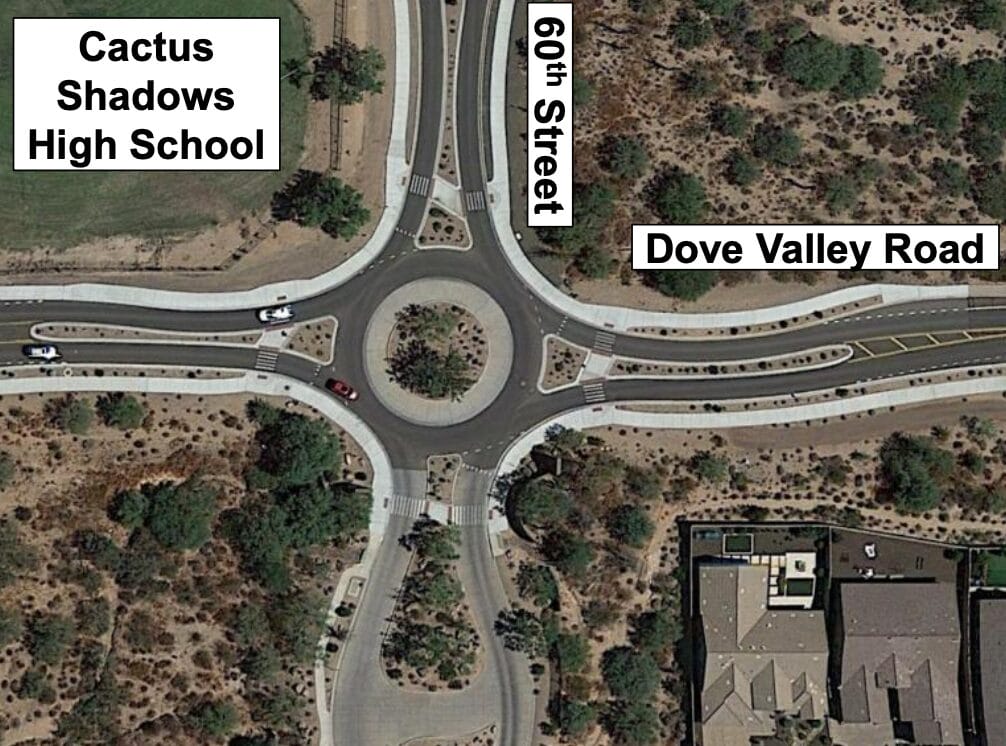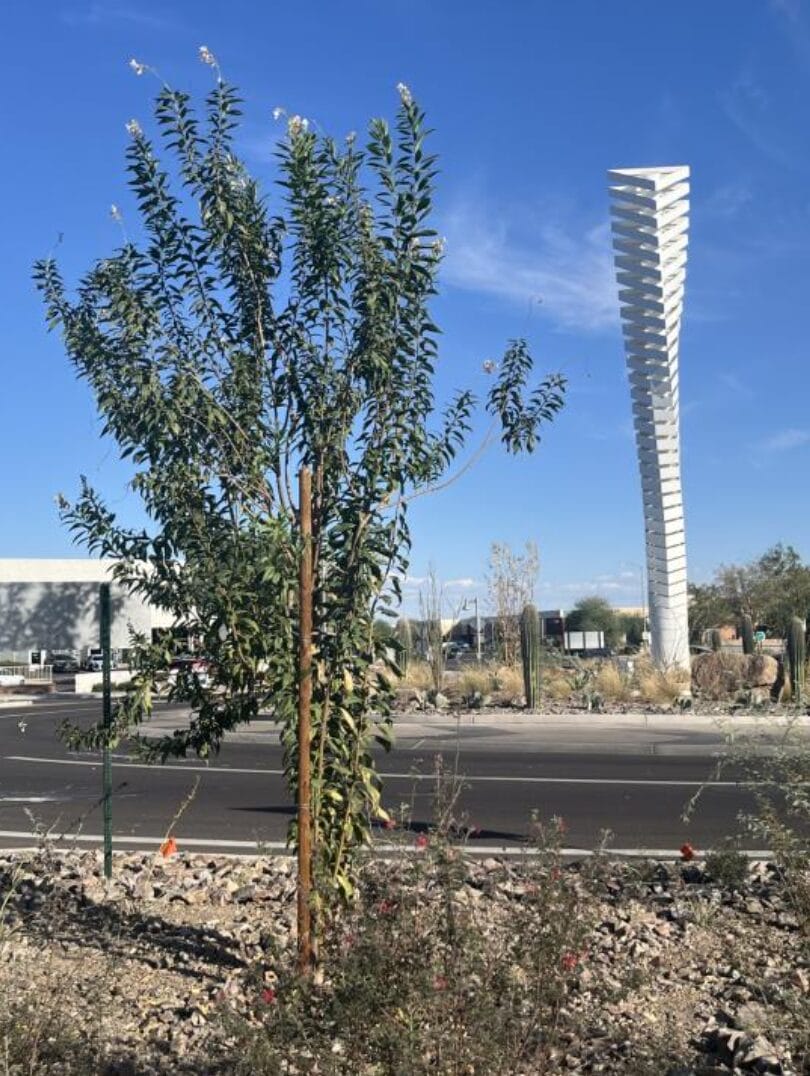The Western Spirit Museum of the West at Marshall and Main
By Paul Basha, Summit Land Management Traffic Engineer
Roundabouts are larger, traffic circles are smaller. Once upon a time, there was minimal difference between roundabouts and traffic circles. As designs have advanced in the past 10 to 20 years, there are dramatic design differences between roundabouts and traffic circles. The purposes of roundabouts and traffic circles are very different.
Roundabouts are a much more efficient alternative to traffic signals or four-way stops. Roundabouts are installed on arterials, and are designed for very efficient, very safe, low-speed travel. Traffic circles are for neighborhood streets to encourage slow speeds. Neither roundabouts nor traffic circles are perfect in every situation – mimicking humans that way.



Traffic circles must gently force vehicles to deviate from straight line speeding. The road must be sufficiently wide to fit the traffic circle, then narrowed to allow drivers to proceed slowly. Often traffic circles are combined with other traffic calming devices to reinforce slow travel speeds.
And in Scottsdale, even small traffic circles can be attractive, such as near the Western Spirit Museum of the West at Marshall and Main (pictured above), thanks to Ed Mell’s Jack Knife.
Traffic circles are intended for low volume roads to prevent speeding.

Roundabouts are intended for intersections where there are many cars from all approaches. Roundabouts are only effective with moderate traffic volumes. If traffic volumes are too low, drivers become inattentive of the potential for other traffic. Some turn left in front of the roundabout or some drive straight across curving lane lines. If traffic volumes are too high, chaos results. Though, would a signal make that photographed situation better?
Roundabouts became common in Scottsdale early this century. The Council-adopted 2016 Transportation Master Plan states, “Roundabouts shall be the first consideration for all intersections of one or two-lane-per-direction streets. Traffic signals should only be installed or remain if specific analysis justifies their superiority.”
Traffic signals, by definition, stop some cars so other cars can go. Traffic signals are so dedicated to their responsibilities that they often stop cars when there are no other cars to go. Instead of the time-consuming go-stop-go tedium of traffic signals and four-way stops; roundabouts recognize that continuously slow-moving cars travel safer and faster than cars braking, waiting, and accelerating. Though my new car has a nice touch, a “hold brake” button so that my foot does not tire holding the brake down while I wait. Small comfort. I’d rather not stop.

In 2005, the intersection of 96th and Sweetwater was converted from a four-way stop to a roundabout instead of a traffic signal. No more did people always have to stop whether or not a conflicting vehicle was approaching. If a conflicting vehicle approached, the drivers adjusted their speed to merge – kind of like some people do illegally and unsafely at stop signs.
Roundabouts were installed in 2008 on Cactus Road at 100th Street, 104th Street, and 108th Street. Likely all three intersections would have signals now and much congestion and waiting, if not for the enlightened use of roundabouts.

In 2014, the City of Scottsdale began construction of a roundabout at the intersection of 60th Street and Dove Valley Road. The adjacent Cactus Shadows High School officials, citing new drivers, much desired the known of a traffic signal rather than the unknown of a roundabout. After completion; when students, faculty, and administrators experienced driving the roundabout; they much preferred the roundabout to a traffic signal.
From 2019 through 2023, there were a total of three collisions in five years.

The first multi-lane roundabout in Scottsdale opened in 2013 at the intersection of Hayden Road and Northsight Boulevard. The long queues of stopped vehicles when the intersection was a signal did not reappear with the intersection as a roundabout. Traffic volumes increased, collisions decreased slightly, collision rates decreased, injury collisions decreased dramatically, and travel times decreased.

The sculpture within the roundabout is “Aspire” created by Simon Donovan and Ben Olmstead. We can unimaginably soar when others help.


The second multilane roundabout in Scottsdale opened in March 2018. This roundabout serves the Mustang Library on the east and Scottsdale Fiesta on the west. It is approximately 350 feet south of the signalized main entrance to HonorHealth Shea on the east and Scottsdale Fiesta on the west. This roundabout received international acknowledgement in the November 2019 edition of the Institute of Transportation Engineers Journal Public Agency Showcase. The design was recognized for safe and efficient accommodation of pedestrian access, car travel, and five bus routes. The project also includes bicycle path connections east to the Camelback Walk.


The close proximity of a traffic signal and a roundabout provides a perfect opportunity to compare their operation. Include on your bucket list later this year standing on the sidewalk between the two operations and deciding for yourself which has less delay and less collision potential.
While there, ponder two stunning aspects of the project. The spiral staircase landscaping in the roundabout captures and filters rainwater directing it into the ground – saving rainwater from entering the street. Also, throughout the area, are 20 sculptures of birds reading books. Mary Lucking’s beautiful work is named Birdie Umwelt and was honored for the People’s Choice Award in the Public Spaces category at the eighth annual International Collaboration of Design + Art in 2020.
A third multi-lane roundabout opened in the Scottsdale Airpark within the past year. The aerial photograph below was taken in September of 2023 while it was in construction. In May of this year, the beautiful sculpture in the center was installed. Beautiful during the day, gorgeous at night. Keep your eye on the road – take turns driving with a friend. It’s ok, you can go around it easily several times. And because of the sculpture design, it appears to rotate as you circle the roundabout. The driver needs to focus on driving, passengers can have the visual experience.

The sculpture was created by Phillip K. Smith, who named it “TRI-HEX-CIRC”. Scottsdale Public At described it thus: “The sculpture geometrically transforms from a circle at its base to a hexagon at its middle, and finally, to a triangle at the top as it lifts 50 feet, engaging the ever-changing desert light and expansive sky.”

Notice the reflection of the sculpture in the car windshield.
Just as each human is more than bones and organs, a City is more than asphalt and traffic signals. Each of us is beautiful in our uniqueness, as should be each part of our City.
Curious about something traffic? Call or e-mail Paul at (480) 505-3931 and pbasha@summitlandmgmt.com.








